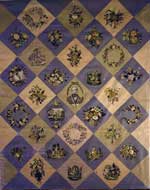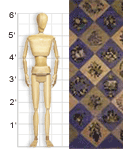VAM galleries including this work:
The Kentucky Library and Museum | Kentucky Past and Present || VAM Home
Anonymous
HENRY CLAY PORTRAIT QUILT, c. 1843-1860
Piecework, appliqué, and embroidery; 102" X 81"
1984.34.1
The Kentucky Library and Museum, Western Kentucky University
The Henry Clay Portrait Quilt is composed of 31 quilted panels. Its design, which varies from block to block, includes embroidered wreaths, leaves, vines, and flowers as well as a pastoral scene of people, birds, and animals. The focal point of the quilt is a needlework portrait of Clay based on an oil portrait painted by John Neagle in 1843.
Henry Clay (1777-1852) moved to Kentucky in 1797 and became one of the state’s—and the nation’s—most prominent 19th-century political leaders. He served in the state legislature, represented Kentucky in the United States Senate and House of Representatives, and was speaker of the U.S. House. Renowned for his statesmanship, he helped negotiate the treaty that ended the War of 1812 and served as secretary of state in the administration of John Quincy Adams. He was also a leader of the Whig Party and sought the U.S. presidency (unsuccessfully) four times. History remembers Clay for his role in engineering the second Missouri Compromise and the Compromise of 1850. He died in Washington, D.C., in 1852.
Some researchers believe that Clay’s wife, Lucretia Hart Clay (1781-1864), made the portrait quilt as a gift for John Crittenden, a friend and political ally of her husband.
Classroom Ideas
Discussion: What types of needlework skills were used to create this elaborate quilt? Why do you think someone would make a portrait quilt? What might be the challenges of creating a needlework version of an oil painting? How are the elements of art used in this work? Do you think the artist was successful in achieving a unified design for the quilt in spite of the varying patterns? Why or why not?
Compare this historical quilt to the contemporary examples in the Museum of the American Quilter’s Society gallery. How are they different? How are they similar?
Activity: Choose a historical figure or contemporary person you admire and design a portrait quilt showing him or her.
Note: The Kentucky Library and Museum offers a “Quilting and Education Guide” that provides historical information and activities for students and teachers.
Links
Find out more about Henry Clay at the web site for Ashland, his Lexington estate.
[www.henryclay.org]
Henry’s wife, Lucretia Hart Clay, is profiled on the McNally Family Page.
[www.airtanker.com/mcnally/hart/lucretia.html]
Judy Anne Johnson Breneman’s America’s Quilting History page includes a variety of articles on quilts and the women who made them.
[www.womenfolk.com/historyofquilts/]
For numerous images of quilts and information on quilting traditions, visit the Southern Quilting web site.
[xroads.virginia.edu/%7EUG97/quilt/opening.html]
See a variety of classroom quilt ideas at Mr. Patch’s Quilt Club, created by students in the San Mateo-Foster City (California) School District.
[www.smfc.k12.ca.us/technology/mrpatch/]
Read an article about American quilts of the 19th century at Fabrics.net.
[www.fabrics.net/Laurette19thCentury.asp]




